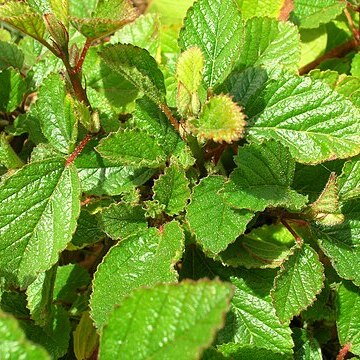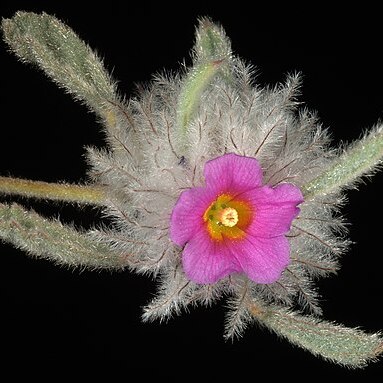Subshrubs [herbs, shrubs], prostrate to erect, taprooted. Stems unarmed, hairy, hairs stellate and/or simple, sometimes also glandular. Leaves petiolate; stipules deciduous, narrowly triangular or linear-triangular; blade: margins dentate, serrate, or crenate. Inflorescences axillary, cincinni in double or compound dichasial clusters, glomerulate, or paniculiform, 5–40-flowered; epicalyx absent; bracts 4, unilateral subtending floral pair, unequal or subequal. Flowers sweet-smelling, sessile or subsessile, homostylous [mostly distylous]; sepals connate 1/2–2/3 length, nectary present; petals late-deciduous, pale yellow, bright yellow, or yellow-orange, usually darker in corolla throat, spatulate, clawed [rarely not clawed], lamina obovate, oblong, oblanceolate, or obtriangular; androgynophore absent or present, to 0.7 mm; stamens connate most of length [connate basally to entirely]; anthers 2-thecate, oblong or ovate; staminodes 0; ovary 1-locular, obovoid or obconic, stipitate or not; ovules 2 per locule; styles included, cylindric; stigmas 10–40-branched, apex slightly exserted above stamen apices and corolla. Fruits capsules, 1-locular, obconic, obovoid, or oblique, apically hairy, dehiscence partially or completely loculicidal. Seeds 1(or 2) per locule, brown or black, slightly laterally compressed, obovoid, obconic, or oblique, smooth or minutely granulate; endosperm present; cotyledons oblate [widely elliptic to elliptic, circular]. x = 5, 6, 7, 10, 13.
More
Herbs or shrubs, the pubescence chiefly of stellate hairs. Leaves alternate, simple, petiolate, stipulate, the stipules deciduous, the blade crenate to serrate, 3-to 5-nerved at the base. Inflorescences axillary or terminal, of globose, sessile or pedunculate clusters, sometimes of scorpioid spikes or branched cymes. Flowers hermaphrodite, actinomorphous, sessile or subsessile, bracteolate; calyx gamose-palous, 5-lobate, 10-nerved, persistent; petals, 5, adnate to the base of the staminal tube, contorted, marcescent; stamens 5, more or less long-connate at the base into a staminal tube, the anthers 2-thecate, the thecae parallel, extrorse, more or less medifixus, longitudinally dehiscent; staminodes none; ovary sessile, 1-celled, 2-ovulate, the ovules ascending; style somewhat excentric, often geniculate near the middle; stigma clavate or plumose-papillate. Capsules 2-valved, 1(-2)-seeded, the seeds small, albuminous; embryo straight; cotyledons flat.
Herbs or subshrubs, rarely woody, stellate puberulent. Stipules lanceolate; leaves simple, margin serrate. Inflorescence terminal or axillary, cymose, often congested. Flowers small, bisexual. Calyx 5-lobed. Petals 5, spatulate, persistent. Stamens 5, connate at base, opposite to petals; anthers 2-thecate, thecae parallel. Ovary sessile, 1-celled; ovules 2; style clavate or fimbriate at apex. Capsule 2-valved. Seed 1, with copious endosperm; cotyledons flat.


